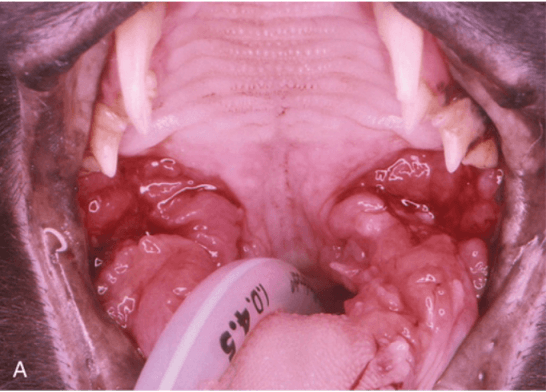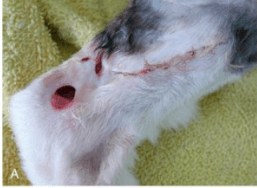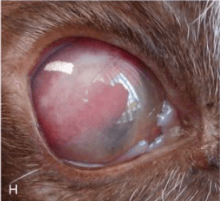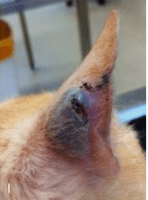Feline AIDS
Feline AIDS, medically referred to as Feline Immunodeficiency Disease (FID), is caused by the Feline Immunodeficiency Virus (FIV). While FIV shares structural and genetic features with the human immunodeficiency virus (HIV)—both being members of the Lentivirus genus—the two are entirely different viruses and are species-specific, meaning they cannot cross-infect.
FIV was first identified in 1986 by researchers Pedersen and Yamamoto at the University of California, Davis, in a group of domestic cats showing signs of immune dysfunction and opportunistic infections. It was initially referred to as “feline T-lymphotropic virus.” Genetic evidence suggests that FIV originated in Africa, most likely among wild feline populations, and later spread worldwide to both wild and domestic cats.
Virus Overview
FIV is an enveloped RNA virus belonging to the genus Lentivirus within the Retroviridae family. Like other retroviruses, FIV has a three-layered structure composed of:
- A genome–nucleocapsid complex with helical symmetry
- An icosahedral capsid
- An envelope embedded with glycoprotein spikes
Although the terms “cat AIDS” and “human AIDS” may sound alike, it is essential to understand that FIV and HIV are fundamentally different viruses. They are species-specific and cannot be transmitted between cats and humans.
Feline AIDS is a long-term illness driven by FIV, which targets and gradually impairs the cat’s immune system. As a result, infected cats become more vulnerable to secondary conditions like upper respiratory infections and oral inflammation (stomatitis). While FIV itself isn’t directly fatal, it compromises the cat’s immune defenses, diminishing overall health and well-being over time.

Epidemiology of FIV
Feline Immunodeficiency Virus (FIV) occurs worldwide. The infection rate among asymptomatic cats ranges from 1% to 14%, while it reaches 44% among cats showing related clinical symptoms. Cats living in groups, stray cats, and feral cats have significantly higher infection rates compared to individually housed domestic cats. Male cats are more commonly infected than females, and neutered cats have a lower infection rate. In addition, the disease has a long incubation period, typically around three years. The average age of cats showing clinical signs is about 10 years, so naturally occurring cases are mostly seen in middle-aged and older cats. Feline Immunodeficiency Virus (FIV) occurs worldwide. The infection rate among asymptomatic cats ranges from 1% to 14%, while it reaches 44% among cats showing related clinical symptoms. Cats living in groups, stray cats, and feral cats have significantly higher infection rates compared to individually housed domestic cats. Male cats are more commonly infected than females, and neutered cats have a lower infection rate. In addition, the disease has a long incubation period, typically around three years. The average age of cats showing clinical signs is about 10 years, so naturally occurring cases are mostly seen in middle-aged and older cats.
| Risk Category | High Risk | Low Risk |
|---|---|---|
| Sex | Male | Female |
| Neuter Status | Intact | Neutered |
| Brced | Mixed breed | Purebred |
| Environment | Free-roamig | Mncoors |
| Health Status | Sidx | Healthy |
| Aae | Adutt | Juvenile |
| Country/Region | Cat Population sampled | Antbooy Prevalence Rate |
|---|---|---|
| USA and Canada | Domestic & shelter Cats | 3.60% |
| Gemany | Domestic Cats | 3.60% |
| Northwestem china | Domestic & Shelter Cats | 9.12% |
| UK | Cats | 3% and 11.4% |
| Malaysia | Domestic Cats | 10.00% |
| Sincapore | Domestic & shelter Cats | 16.00% |
FIV is primarily spread through blood and bodily fluids, most commonly during fights where cats bite and injure each other. Although the virus can also be passed from a mother to her kittens (known as vertical transmission), this route is relatively uncommon. The risk largely depends on how much virus the mother carries during pregnancy and birth. If she’s in the acute phase of infection, up to 70% of her kittens may become infected. But if the infection is dormant or subclinical, transmission is highly unlikely.
Clinical Symptoms
The symptoms of feline AIDS share some similarities with those of human AIDS. The disease typically unfolds in three stages: an initial acute phase, a prolonged asymptomatic carrier phase, and finally, full-blown immunodeficiency, during which secondary infections take hold and cause a range of illnesses. In the early stages, signs may be subtle—such as swollen lymph nodes, mild fever, and lethargy. Over time, however, affected cats can develop chronic conditions like stomatitis, gingivitis, and periodontitis, as well as persistent diarrhea that doesn’t respond to treatment, stubborn upper respiratory infections, unexplained fevers, and even neurological issues like behavioral changes, disorientation, dementia, facial twitching, or seizures. Other common signs include nasal discharge, weight loss, eye problems like glaucoma and uveitis, low-grade fevers, and general depression.
Acute Phase:
This initial phase usually lasts for about four weeks or more. During this time, the virus multiplies rapidly and begins to interfere with the cat’s immune system. CD4+ T cell levels drop sharply within the first week, while CD8+ T cells increase, leading to an altered CD4:CD8 ratio—a key marker of immune imbalance. Clinically, signs are often mild and short-lived, including fever, fatigue, swollen lymph nodes, and reduced appetite. In some cases, cats may also develop eye problems such as uveitis or glaucoma, with symptoms like redness in the front of the eye (aqueous humor), inflamed iris, constricted or uneven pupils, adhesions in the iris, and small white spots in the vitreous body.
Chronic Asymptomatic Phase:
This phase can persist for many years—and in some cats, it may even last a lifetime. During this time, the virus continues to replicate quietly in the peripheral lymph nodes. CD4+ T cell levels may temporarily recover but tend to decline gradually over time. Most cats show no obvious symptoms and appear generally healthy, though they are in a subclinical carrier state. Still, FIV is actively disrupting the immune system in the background, encouraging T cell death and slowly undermining the cat’s immune defenses. Fortunately, many cats are able to maintain a stable immune balance throughout this phase and live outwardly normal, healthy lives.
Immunodeficiency Phase:
If the cat’s immune system loses its balance during the chronic stage, the disease can advance into full-blown immunodeficiency. At this point, lymphocytes—key immune cells—are severely depleted, leaving the immune system badly compromised. This immunosuppression opens the door to a range of secondary infections and autoimmune disorders, including chronic stomatitis, immune-mediated glomerulonephritis, B-cell lymphoma, and even multiple myeloma.




Diagnostic Methods
The diagnosis of Feline Immunodeficiency Virus (FIV) primarily involves virological testing and hematological examination. Virological methods include antibody detection, virus isolation and culture, and polymerase chain reaction (PCR) testing. Among these, antibody testing is the most commonly used diagnostic method; however, false positives may occur, so clinical veterinarians must interpret the results with caution. PCR testing offers high specificity by amplifying viral nucleic acids, thereby improving both the sensitivity and accuracy of detection. Hematological examinations may reveal abnormalities such as leukopenia, anemia, and thrombocytopenia.
Treatment Recommendations
At present, there is no specific medication that can cure Feline Immunodeficiency Virus (FIV). However, a cat’s lifespan can be extended and its quality of life improved by controlling secondary infections and boosting the immune system. Treatment options include basic fluid therapy, antimicrobial and anti-inflammatory treatment, broad-spectrum antiviral therapy, and immunomodulatory (immune-enhancing) therapy. After a confirmed diagnosis, symptomatic treatment is recommended, and a personalized treatment plan should be developed based on the individual condition of the cat. Some targeted treatments may cause serious side effects and should be used cautiously under veterinary supervision.
| Treatment Plan | |
|---|---|
| Etiological Treatment | Recombinant feline interferon omega (VirBagen Omega):Administered at 1 MU/kg subcutaneously (SC), every 24 hours for 5 days, repeated on day 14 and day 60. Alternatively, an oral regimen can be used (0.1 MU/cat feIFN-ω, PO, every 24 hours for 90 days). It is safe, non-immunosuppressive, and has been shown to effectively reduce viral replication and improve clinical symptoms, although it has no effect on survival rate. |
| Etiological Treatment | AMD3100 (Plerixafor):A selective CXCR4 antagonist that can improve clinical symptoms or reduce viral load, but it cannot reverse disease progression. It has relatively mild side effects in cats and is currently used more in research. |
| Etiological Treatment | Prednisolone:Dosage: 5–10 mg/kg orally or subcutaneously every 12 hours. It can suppress viral replication and improve clinical symptoms, especially for chronic inflammation. A rare side effect is non-regenerative anemia. Full blood counts are recommended before and during treatment—weekly for the first month, and every 2–4 weeks afterward. Resistance may occur after 2 months. |
| Symptomatic Treatment | Provide symptomatic treatment based on the cat’s clinical manifestations, such as using antibiotics for infections and anti-diarrheal medications for diarrhea. Stomatitis: Prednisolone may be effective; combining full-mouth tooth extraction yields better results. Chronic rhinitis: Topical corticosteroids and other non-steroidal anti-inflammatory drugs for upper respiratory inflammation may be used. |
| Immunomodulators | Thymosin α1: Commonly used, but may be combined with other therapies. Recommended for cats at higher risk of disease progression. |
| Supportive Therapy | Provide nutritional support through high-quality food, maintain balanced nutrition, and help boost physical strength. |
Preventive Measures
The key to preventing Feline Immunodeficiency Virus (FIV) is to reduce contact and fighting between cats. Effective preventive strategies include:
Indoor Housing:
Keeping cats indoors, especially avoiding free-roaming, significantly reduces the risk of exposure to potential sources of infection.
Regular Health Checkups:
Schedule routine veterinary examinations, including blood tests, to detect early signs of viral infection.
Environmental Hygiene:
Maintain a clean living environment for your cat by regularly disinfecting litter boxes, food bowls, and water dishes.
Quarantine for New Cats:
Isolate and observe any newly introduced cats to ensure they are not infected before allowing contact with resident cats.
Feline AIDS is a chronic viral infectious disease, but with proper preventive measures and timely treatment, the progression of the illness can be effectively managed, and the cat’s quality of life can be significantly improved. It is hoped that this article will help pet owners better understand and cope with this disease, ultimately safeguarding the health and well-being of their feline companions.
